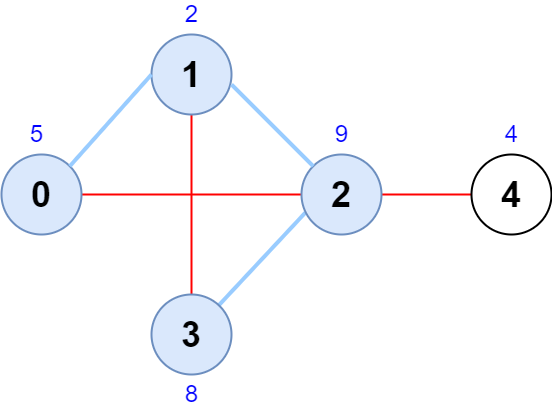2242. Maximum Score of a Node Sequence


Description
There is an undirected graph with n nodes, numbered from 0 to n - 1.
You are given a 0-indexed integer array scores of length n where scores[i] denotes the score of node i. You are also given a 2D integer array edges where edges[i] = [ai, bi] denotes that there exists an undirected edge connecting nodes ai and bi.
A node sequence is valid if it meets the following conditions:
- There is an edge connecting every pair of adjacent nodes in the sequence.
- No node appears more than once in the sequence.
The score of a node sequence is defined as the sum of the scores of the nodes in the sequence.
Return the maximum score of a valid node sequence with a length of 4. If no such sequence exists, return -1.
Example 1:

Input: scores = [5,2,9,8,4], edges = [[0,1],[1,2],[2,3],[0,2],[1,3],[2,4]] Output: 24 Explanation: The figure above shows the graph and the chosen node sequence [0,1,2,3]. The score of the node sequence is 5 + 2 + 9 + 8 = 24. It can be shown that no other node sequence has a score of more than 24. Note that the sequences [3,1,2,0] and [1,0,2,3] are also valid and have a score of 24. The sequence [0,3,2,4] is not valid since no edge connects nodes 0 and 3.
Example 2:

Input: scores = [9,20,6,4,11,12], edges = [[0,3],[5,3],[2,4],[1,3]] Output: -1 Explanation: The figure above shows the graph. There are no valid node sequences of length 4, so we return -1.
Constraints:
n == scores.length4 <= n <= 5 * 1041 <= scores[i] <= 1080 <= edges.length <= 5 * 104edges[i].length == 20 <= ai, bi <= n - 1ai != bi- There are no duplicate edges.
Solution
maximum-score-of-a-node-sequence.py
class Solution:
def maximumScore(self, scores: List[int], edges: List[List[int]]) -> int:
d = defaultdict(list)
def go(x, y):
if len(d[x]) == 3:
heapq.heappushpop(d[x], (scores[y], y))
else:
heapq.heappush(d[x], (scores[y], y))
for x, y in edges:
go(x, y)
go(y, x)
res = float('-inf')
for x, y in edges:
for score1, node1 in d[x]:
for score2, node2 in d[y]:
if node1 not in (x, y) and node2 not in (x, y) and node1 != node2:
res = max(res, scores[x] + scores[y] + score1 + score2)
return -1 if res == float('-inf') else res